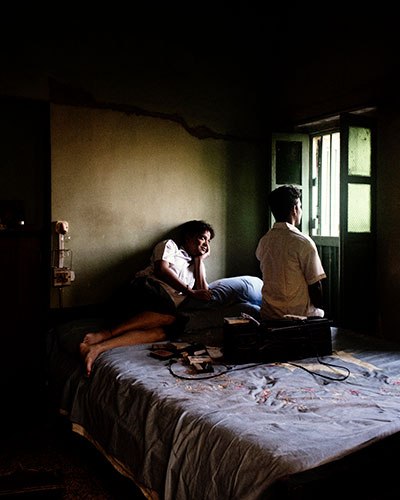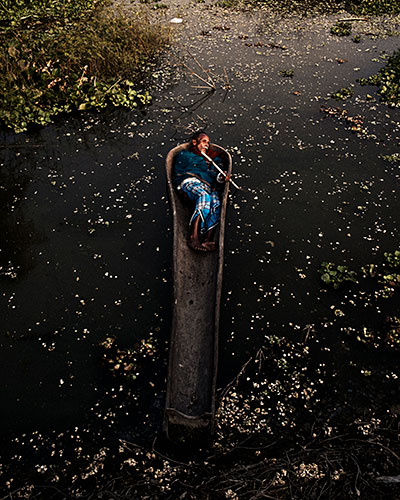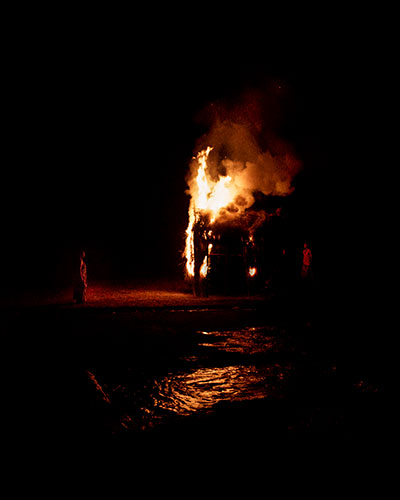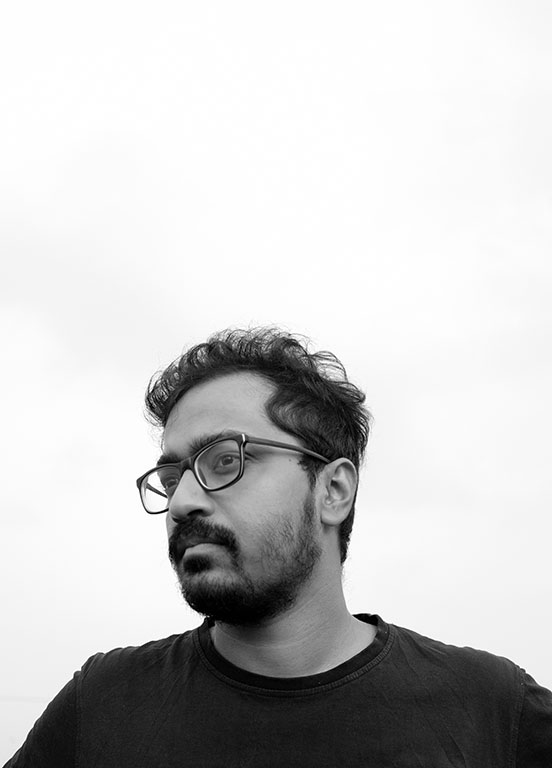
Over the last sixteen years, a friend had been experiencing a recurrent dream: she has returned home from an unknown war and is sitting on a chair beside a window. A corpse lay on the bed (her sister had died in this room). The dead person’s identity always remained elusive in the dream setting her off to wonder if the corpse is of her lover, sister or mother. She further wondered, why is she wearing a warrior’s uniform? Is it because she has been fighting (for acceptance)? Or is it because her mother always told her that it would be a crime for her to love another girl? The only clarity she has from the dream is the anxiety she faces in pursuit of the love of her choice. Gradually, I began listening to the dreams, desires, and nightmares of many other friends and acquaintances who pursued same-sex love. And that led to the making of Full Moon on a Dark Night.
This work was exhibited before the decriminalization of Section 377 of the Indian Penal code. I used many visual metaphors – a mask, a tiger in the wild, a choppy sea engulfing a man struggling against the current etc, to evoke notions of censorship, surveillance, and feelings of suffocation and anxiety. Using the anecdotes and fantasies that surface during my conversations and interviews with the people I photograph, I recreate scenes that tease the boundaries between truth and fiction. For a community whose voice is often marginalized, I believe, this imagined reality offers a rare refuge – one where desires and aspirations are freely explored and expressed without inhibitions.
Extensive research and engagement with my photographic collaborators over a prolonged duration fuels and shapes my practice. Projects such as Full Moon on a Dark Night (2015-ongoing), Where the Birds Never Sing (2017-2020) and Let’s Sing an Old Song (2012-2015), enmesh fiction and reality to deal with issues like identity, notions of linearity, emotions, desires, as well as memories and their fragmentation. These address the aporia of the linear visual narrative and try to initiate nuanced dialogs. I try to immerse my viewers into a surreal universe, one that exists parallelly but most refuse to acknowledge.
In Where the Birds Never Sing, I deep-dived into the history of 1979 Marichjhapi massacre – thousands of Bangladeshi refugees from Marichjhapi Island in Sundarban, West Bengal, were forcibly evicted, killed in police encounters as well as by starvation and diseases. The atrocities of this event resonate with several other contemporaneous narratives of communal disharmony and the repetitive nature of violence in the politics of the subcontinent, especially in the context of Kashmir and the present situation of Bangladeshi migrants vis-a-vis NRC (National Register of Citizens).
Archives and legal documents play a pivotal role in my narrative approach by providing a verifiable balance to my docu-fictional narratives. I traveled to distant places to track the people referenced in the documents. I spent time listening to their stories as they unveiled their traumatic memories. I tried to understand as to how they dealt with the trauma they had been carrying for decades. The intricate weaving of fact and fiction, past and present, enlightens several perspectives of the same narrative, thus forming a cryptic framework to be decoded by the viewers.
While working on the story of Marichjhapi massacre, I was photographing an abandoned derelict boat when it started to rain. We ran for shelter, but I slipped and got my clothes soiled. We decided to wait out the rain under a tree, when we heard a distant scream calling out, “Lokhhii…. Lokhiiiii….” An old couple was shouting their daughter’s (or may be daughter-in-law’s) name. As far as we could see, there was no one on the riverbank. The old couple sailed into the rain presumably in search for lokkhi. I don’t know if they had found their daughter, but this incident affected me a lot. When I interviewed the survivors, many of them shared that those who could escape the massacre “…ran or swam away to other islands where they waited for their loved ones for a very long time.” Some returned, many did not. This particular incident helped me to make this image of a woman staring at the horizon with her back towards the camera.
Let’s Sing an Old Song (2012-2015) is a series of staged and constructed portraits of theater artists from Bengal’s Jatra (Bengal folk theatre form) that came to fruition from another personal experience. My uncle, a retired Jatra artiste, was compelled to join a railway factory, hoping to do what he could not as an artiste – earn a living. I started photographing many other struggling artistes who were once gigantic figures in Bengal, but were now unemployed and forgotten. I followed a similar approach as I previously described, using a host of approaches including the characters they had played, their psychological underpinnings etc. Through an intensive engagement over long durations with my collaborators, I try to bring out the little ruptures that are hidden somewhere in the canonical narrative. Time is of great essence here. I use individual and collective narratives in building a shared narrative that can resonate amongst a wider audience.
A Discreet Exit Through Darkness, my latest venture is on the disappearance of my mother during the autumn of 1969. She had been sent to the neighborhood sweet shop to buy sweetmeats for a religious offering on the 24th of October. The little girl of nine went prancing to the confectionery but did not return, until three years later. The strangest part, however, lies in the fact that my mother is unable to recall anything from those three years. Her memory of that period has been wiped clean. She lives her childhood through two phases of her past – one that existed before her disappearance and the other that characterized her life after she returned. The intervening years are a massive void.
Using my visual response, I attempt to understand and articulate the multiplicity of the many entwined layers by delving deep into the darkest reaches of my family’s history and examine its conflicts with the personal narratives of the household members regarding a more than half-a-century-old incident .
My ancestors migrated from Bangladesh during partition. I grew up listening to their stories of struggle, estrangement from homeland, and migration in search of a new home…. If you observe closely, you might notice how my roots, or the pursuit of them, have influenced my artistic response. For example, I heard about Marichjhapi during my family conversations and later, when I was working on Let’s Sing an Old Song, I had visited Sundarban for the first time. Here, I witnessed the land where the massacre had happened. Simultaneously, cinema and vernacular literature has had a significant impact in shaping my gaze and aesthetic sensibilities.
In the documentary fiction film Close-Up (Director: Abbas Kiarostami), Sabzian, a real-life person who had impersonated a real-life filmmaker, Mohsen Makhmalbaf, is taken to court by a family he has deceived. The film recounts Sabzian’s trial and imprisonment. Kiarostami heard the story from a journalist and made the layered film with part archival footage of the courtroom trials and part re-enactments in which Sabzian plays himself, eventually merging fiction and documentary when Sabzian and Makhmalbaf actually meet in the end. Another film, A Moment of Innocence (1996; Director: Mohsen Makhmalbaf), about a real experience of 17-year-old Makhmalbaf (the same filmmaker character from Kiarostami’s Close-Up) stabbing a policeman (at a protest rally) and sentenced to five years of imprisonment. Twenty years later, he made amends with the policeman he had stabbed. Though the entire film is a re-enactment, all the characters were real.
Both these films, made on a very low budget, inspired me immensely, especially when I started working on the Jatra series immediately after completing my photographic education at Pathashala in Dhaka. I was literally penniless then. I learned and reminded myself that “…we don’t need expensive cameras, a big crew etc to make a masterpiece.” Most of the time, I work with real people, real heroes, but also re-create scenes. I believe that Kiarostami and Makhmalbaf were inspired by the French New Wave cinema and subsequently their movies further contributed to the Iranian Neorealism movement.
From Bengali literature, Sunil Gangopadhyay’s Sei Somoy (1991; Those Days) and Manik Bandopadhyay’s Padma Nadir Majhi (1936; Boatman of the River Padma) have left an indelible impression on me. Sei Somoy is a historical fiction situated in the nascent years of Bengal Renaissance (1840–70). The flavor of the decadent Bengali aristocracy in the 19th century interspersed with real and imaginary characters from that time infused life and personality into those historical characters about whom we all know, but never the actual person. It is one of those rare historical fictions that gets history and fiction right. I fell in love with this narrative approach.
Simultaneously, Bandopadhyay’s novel is about a poor fishermen community living on the banks of the River Padma in a fictitious village called Ketupur. Perennially dependent on the river for fish, the lives of the fishermen community form the central narrative arc, particularly revolving around Kuber, a poor fisherman who lives with his wife, daughter, and two sons. The sole bread-earner of his family, he befriends a local businessman, Hossain Miya, suspected of human trafficking. At the heart of Hossain Miya’s rags-to-riches story stands Moynadip, a remote silt bed island or char. He traffics victims of floods, cyclones, and social ostracization from different parts of the region to help them make a new beginning.
These characters long haunted me. They pushed me into a state of confusion wondering, “which is real and which is fictional?” leaving me to figure things out alone. These references remain relevant for tackling class politics, nature’s cruelty, social division and corruption, but also remain timeless for their engaging and emotional narratives.
I always research the historical facts of a time period while reading or watching a movie to understand the impact of prevalent political situations on these artists and correlations with their storytelling styles. I believe that a film or a novel can involve fiction, which is beyond reality, a world that exists only in the mind of the artist, but still the creation should be related to reality. This reminds me of a beautiful line from Svetlana Alexievich’s The Unwomanly Face of War, “Remembering is not a passionate or dispassionate retelling of a reality that is no more, but a new birth of the past, when time goes in reverse.”






1. Close-Up. Directed by Abbas Kiarostami. Performed by Mohsen Makhmalbaf, Abbas Kiarostami Hossain Sabzian. 1990.
2. A Moment of Innocence. Directed by Mohsen Makhmalbaf. Performed by Ammar Tafti Mirhadi Tayebi. 1996.
3. Gangopadhyay, Sunil. Sei Somoy. Kolkata: Ananda Publishers Pvt. Ltd., 1991.
4. Bandopadhyay, Manik. Padma Nadir Majhi. Kolkata, 1936.
5. Alexievich, Svetlana. The Unwomanly Face of War: An Oral History of Women in World War II. Russia, 1985.
Copyright © 2022, PhotoSouthAsia. All Rights Reserved.
Soumya Sankar Bose was invited to write this essay for PhotoSouthAsia by our Guest Editor, Sharbendu De. We encourage you to begin with De's introduction, Against Capturing - in a World of Ideas, and to also read De's other invited essayists:
Prajakta Potnis: In the Quest of an Undiscovered Location
Ravi Agarwal: The Entangled Image
 Photograph © Soumya Sankar Bose
Photograph © Soumya Sankar Bose
Soumya Sankar Bose is an Indian documentary photographer. In his practice he uses photography, archival material, text, and film to explore desire, identity, and memory. His first book, Where the Birds Never Sing (2020), is on Marichjhapi massacre, the forcible eviction in 1979 of lower caste Bengali refugees on Marichjhapi Island in Sundarban, India, and the subsequent death of thousands by police gunfire, starvation, and disease. The book was shortlisted for the First PhotoBook Award in the Paris Photo–Aperture Foundation PhotoBook Awards 2020.
Bose was awarded Magnum Foundation's Social Justice Fellowship for Full Moon on a Dark Night. In 2018, he received Magnum Foundation's Migration and Religion Grant. He has received other grants from the Foundation for Indian Contemporary Art's Amol Vadehra Art Grant, Goethe-Institut / Max Mueller Bhavan's Five Million Incidents, Henry Luce Foundation. He is a three-time recipient of grants from the India Foundation for the Arts. In 2019, he was a participant in World Press Photo's Joop Swart Masterclass. Born and brought up in Midnapore, a small town near Kolkata (India), Bose now lives in Kolkata and is represented by the Experimenter Gallery.
20 November